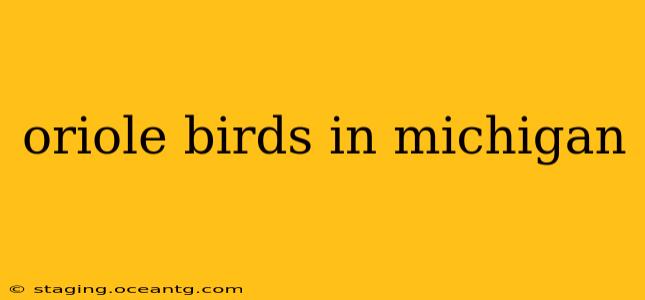Michigan's diverse ecosystems provide habitat for several beautiful bird species, and among them, orioles stand out with their striking plumage and melodious songs. This guide delves into the world of orioles in Michigan, covering their identification, habitat preferences, nesting behaviors, and conservation status. Whether you're a seasoned birder or a curious nature enthusiast, you'll find valuable insights within.
What Kinds of Orioles Live in Michigan?
Michigan is primarily home to two oriole species: the Baltimore Oriole and the Northern Oriole. While both boast vibrant colors, there are key differences in their appearance that help distinguish them. The Baltimore Oriole, a more common sight, displays a rich orange-black plumage, while the Northern Oriole showcases a more subdued yellow-black coloration. Their songs, though similar, also have subtle variations that experienced birders can recognize.
Where Do Orioles Live in Michigan?
Both Baltimore and Northern Orioles prefer habitats with ample trees and shrubs, particularly those offering a good supply of insects and nectar-rich fruits. You're most likely to spot them in:
- Wooded areas: Deciduous forests and woodlots provide ideal nesting and foraging grounds.
- Parks and gardens: Mature trees and flowering plants in urban and suburban landscapes often attract orioles.
- Along rivers and streams: The riparian habitats offer a diverse food source and shelter.
- Orchards and fruit farms: These areas provide a rich source of food, particularly during the fruiting season.
Understanding their habitat preferences is crucial for effective birdwatching and conservation efforts.
When Is the Best Time to See Orioles in Michigan?
Orioles are migratory birds, meaning they spend their breeding season in Michigan and then migrate south for the winter. The best time to see them in Michigan is during their breeding season, which typically runs from April to September. However, the exact timing can vary depending on the weather and the specific species.
What time of year do orioles migrate to Michigan?
Orioles typically arrive in Michigan during late April to early May, with the exact timing dependent on weather conditions. Their departure begins in late August and extends through September. This relatively short window of opportunity underscores the importance of careful observation during these months.
When do orioles nest in Michigan?
Orioles typically begin nesting in May and June. They create intricately woven, pendulous nests, often hanging from the outer branches of trees, typically choosing trees that offer good concealment and structural support.
What Do Orioles Eat in Michigan?
Orioles are omnivorous birds, consuming a variety of food items depending on seasonal availability. Their diet includes:
- Insects: A significant portion of their diet consists of caterpillars, beetles, and other insects, vital for feeding their young.
- Fruits: They also enjoy consuming various fruits, including cherries, berries, and mulberries.
- Nectar: Flower nectar provides an important energy source, especially during migration and breeding.
Providing a diverse array of food sources in your backyard can attract these colorful birds to your garden.
How Can I Attract Orioles to My Yard?
Attracting orioles to your yard requires providing them with the resources they need to thrive. This includes:
- Planting native trees and shrubs: Focus on trees that provide berries and insects.
- Offering a source of nectar: Consider planting nectar-rich flowers such as honeysuckle or trumpet creeper.
- Providing a water source: A bird bath or shallow dish of water is essential.
- Using an oriole feeder: Specialized feeders with orange halves of oranges or grape jelly can be highly effective. However, remember to maintain hygiene to prevent the spread of disease.
What are the conservation concerns for orioles in Michigan?
While not currently facing immediate threats, habitat loss due to deforestation and urbanization poses a significant long-term risk to oriole populations. Protecting and restoring their habitats is crucial to their survival.
This comprehensive guide provides a solid understanding of orioles in Michigan. By appreciating their beauty and actively contributing to their conservation, we can ensure these vibrant birds continue to grace Michigan's landscapes for generations to come.
